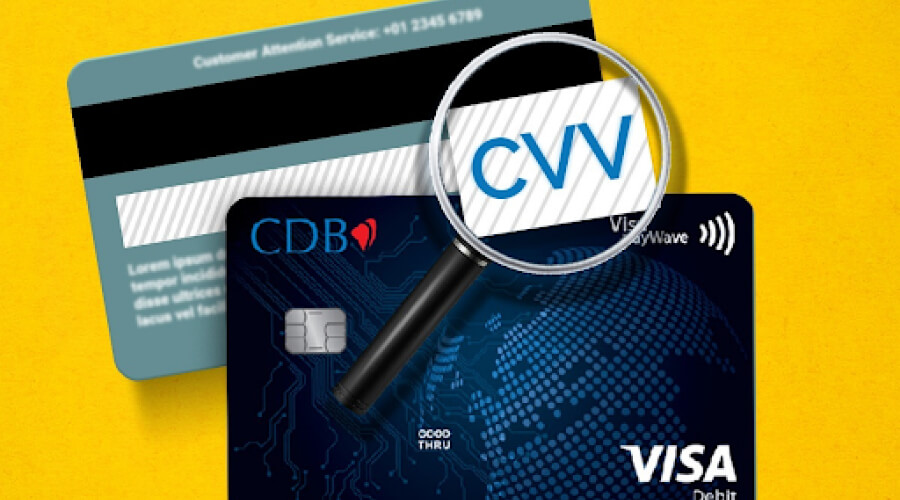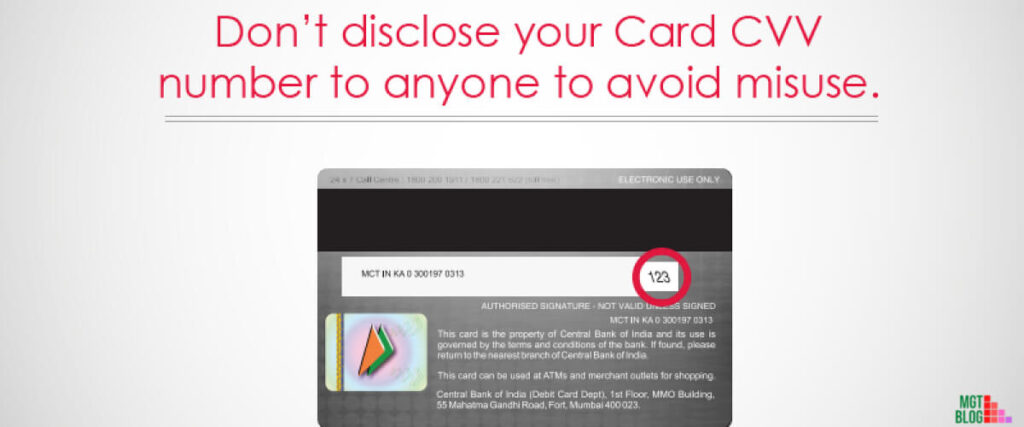CVV stands for Card Verification Value and it is a 3/4-digit number that is embossed or printed on a card for better security. If you have a VISA®, MasterCard® and Discover® branded credit and debit cards then your CVV will be a 3-digit number. On the other hand, if you have American Express® branded credit or debit card the CVV will be a 4-digit numeric code.
You can easily find the CVV number on a debit card. Flip the debit card and you will see a magnetic black strip at the top of the card. Below the strip, there is a white portion for the signature of the customer, and next to the white portion you will find the CVV number of the card. While you are making any purchase using a debit card, you have to mention this number.
What Is A CVV?

A CVV is a 3- or 4-digit number that works as an additional security measure when it comes to credit or debit card fraud. A CVV has many names, for example, Card Security Code (CSC), Card Verification Data (CVD), Card Verification Number (CVN), or Card Verification Value Code (CVVC). All of these names refer to the same concept. Basically, CVV is an additional set of numbers that uses have to provide for transactions where they won’t physically swipe the card or insert its chip. Most cards contain two sets of CVCs. one printed directly on the card and one encoded in the magnetic stripe or chip. When you or the merchant swipes your card, the card processor sees your card number and the CVV encoded on its magnetic strip. It helps the processor know that the card is physically present in the shop and the user is making an in-person transaction. On the other hand, when you do online shopping, over the phone or internet, you have to provide over the phone or internet. The CVV printed on the card is different from the CVV that is encoded on the card’s chip or magnetic strip. So, when the processor sees the printed CVV, it understands that the transaction doesn’t involve in-person interaction; it’s an online transaction.
Purpose Of A CVV
The main purpose of CVV is to provide more security. It’s extra information that fraudsters must have to do a fraudulent activity. There are some rules about the use of CVV that increase the security of the card. For example, stores that collect the information of your debit card, can’t store your CVV information. If hackers break into the merchant’s database, then they might collect information like your card number and expiration date but cannot access your CVV information because it’s not in the server. Therefore, while shopping doesn’t ever share your CVV with the merchant.
How To Find The CVV Security Code
In most cases, you will find the CVV code printed on the back of the card. But in some cases, you might find the CVV printed on the front of the card. For example, the CVV code of American Express is printed on the front of the card. Typically, the number is printed on the right just above the account number. On the other hand, cards that are aligned with other payment processing networks, like Visa, Discover, and Mastercard, have their CVV security numbers printed on the back, near to the security line. In these cards, if your account number is printed on the back then you will find the CVV on the back of the card.
CVV Code Theft Scams
The CVV code protects you and your card issuer against fraud. The CVV code is not stored by the merchant, which means there’s an added layer of protection against fraudulent activities in the event of a data breach. However, there are many ways frauds can obtain your account number and your CVV number and use them to make fraudulent purchases.
Phishing Scam
This is a common CVV code theft scam. You might receive an email that will look like it came from your credit card company and it will ask you to verify your account number and CVV code! So if you provide the information then you’ve just handed over your card information to an identity thief who will use the information to clone your card and use it for unauthorized purchases. You should remove that, credit card companies will never ask for this information. So, if you receive this type of phishing email then you should immediately contact the bank authority.
Keylogging
In this type of scam, a tracking code might be lurking on an insecure website. When you visit the website and type in your card details, the hacker can use a keylogger program to record your information that includes card number, CVV, expiration date, etc. Moreover, keylogging can be introduced to your computer via malware. Therefore, make sure you have a robust, up-to-date antivirus installed on your computer.
How To Protect The CVV Code While Shopping Online?
If you frequently do online shopping and use your debit card then you should protect your CVV while shopping online. Protecting the CVV is similar like you are protecting your other financial or personal information. Here are some tips that you can follow to protect your CVV –
1. You can install a firewall on your computer to protect yourself while shopping online from home
2. You should install antivirus software for an added layer of security on your computer
3. Don’t provide CVV and other financial information to websites that don’t have “HTTPS” at the beginning of the website address
4. Avoid shopping online in public places using unsecured Wi-Fi
5. Share the card information with caution
6. Report a lost or stolen card to your credit card company as soon as possible
FAQs About How Do I Find A CVV Number On A Debit Card?
Is CVV The Same As My Card’s PIN?
The Personal Identification Number (PIN) is not the same as the CVV. Usually, the PIN is used for making in-person transactions with the card at the ATMs. On the other hand, the CVV is used when making online purchases.
What If My Debit Card Doesn’t Have A CVV?
Usually, you will find the CVV on the back of the card. For some cards, the CVV is located on the front of the card. If you don’t find the CVV on the front or back then you should call your card issuer to get your security code.
Can I Find My CVV Number Online?
The CVV number only appears on the back or front of the card. So, won’t be able to get the CVV number online.
Does Every Debit Card Have CVV?
Yes, every debit card has CVV. The CVV number is used for online purchases. Usually, VISA, MasterCard, and Discover cards have three-digit CVV.
Can My Card Be Charged Without CVV?
The CVV is required for transactions where the card is not present like web transactions, phone authorizations, etc. Moreover, if the card is swiped for payment, then CVV is not required. So, your card can be charged without CVV.
References:
1. https://paytm.com/blog/debit-card/what-is-cvv-in-a-debit-card/
2. https://www.dbs.com/digibank/in/articles/save/debit-card-cvv
Last Updated on February 7, 2022 by

Magalie D. is a Diploma holder in Public Administration & Management from McGill University of Canada. She shares management tips here in MGTBlog when she has nothing to do and gets some free time after working in a multinational company at Toronto.





